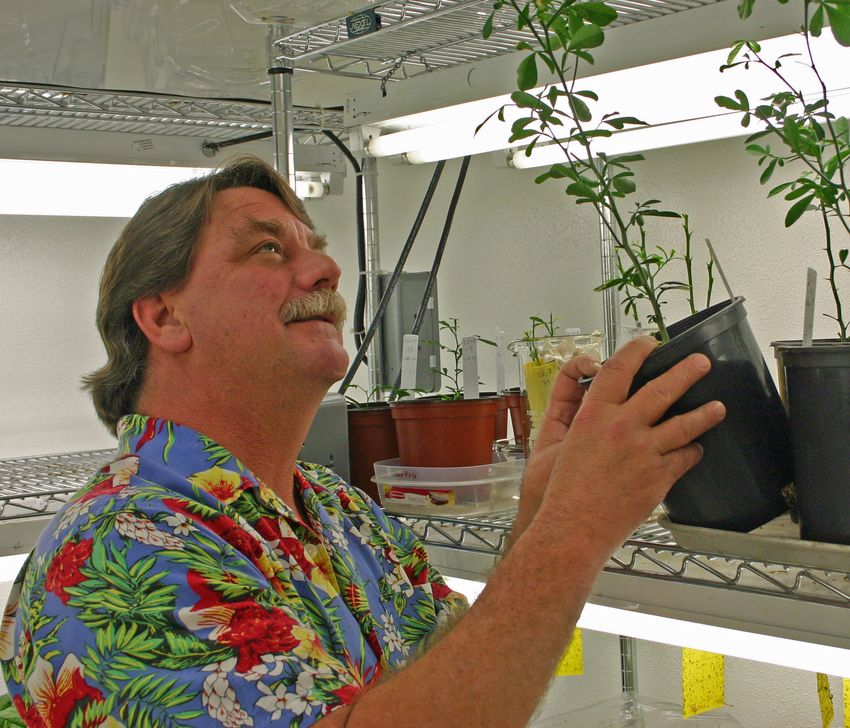http://www.physorg.com/news/2012-03-spinach-genes-deadly-citrus-disease.html
Spinach genes may stop deadly citrus disease
March 27, 2012 By Rod Santa Ana
 Dr. Erik Mirkov, a plant pathologist at the Texas AgriLife Research and Extension Center at Weslaco, will soon field test transgenic citrus trees that have shown immunity to citrus greening disease. Credit: AgriLife Communications photo by Rod Santa Ana
Citrus growers worldwide who currently have no cure for a devastating, tree-killing disease may soon find relief from an unlikely source: spinach.
Dr. Erik Mirkov, a plant pathologist at the Texas AgriLife Research and Extension Center at Weslaco, will soon field test transgenic citrus trees that have shown immunity to citrus greening disease. Credit: AgriLife Communications photo by Rod Santa Ana
Citrus growers worldwide who currently have no cure for a devastating, tree-killing disease may soon find relief from an unlikely source: spinach.
Dr. Erik Mirkov, a Texas AgriLife Research plant pathologist at the Texas AgriLife Research and Extension Center at Weslaco, has transferred two genes from spinach into citrus trees, apparently providing resistance to citrus greening disease, or Huanglongbing, often referred to as HLB.
The transgenic trees have shown resistance in greenhouse trials and will soon be planted in Florida for field testing, he said.
The research is funded by Southern Gardens Citrus, a large citrus and juice producer in southern Florida.
This project started with a three-year grant from the U.S. Department of Agriculture when the interest was to find resistance to citrus canker, Mirkov said. But then citrus greening moved into Florida. Both are bacterial diseases, but citrus greening devastated the industry far worse than canker did.
Mirkov knew that spinach proteins had broad-spectrum resistance against multiple bacteria and fungi, and started testing his transgenic trees against greening.
We injected canker into the leaves of transgenic plants with one spinach gene and found that the bacterial lesions didnt spread, he said. But we also showed that transgenic plants infected in the rootstock with citrus greening disease flourished and produced lots of leaves, while the non-transgenic trees produced just one leaf.
With good greenhouse results, those first generation transgenic trees were taken to the field in 2009, Mirkov said. After 25 months of growth, some of the transgenic trees never showed infection, while 70 percent of the non-transgenic control trees did.
In the meantime, Mirkov developed improved second-, third- and fourth- generation transgenic trees by adding a second spinach gene and improving how and where the genes expressed themselves.
Citrus greening is a bacterial disease that affects the vascular system of the tree, or phloem, he said. It basically shuts off the trees ability to take up and use water and nutrients, causing the tree to die. We were able to improve the transgenic trees by having the genes express themselves in the vascular system.
Mirkov also found that while one spinach gene is more effective than the other, they work better together than they do alone.
The first field trial involved transgenic trees using only the weaker of the two genes, but it worked; it gave us encouragement he said. By using both genes, were hoping to get immunity so that trees are never infected in the field.
Its this fourth generation of transgenic trees that Mirkov said will likely be taken through the lengthy and costly deregulation process that declares the fruit safe to eat.
Its an expensive process that involves contracts with firms that do the actual testing with rats, bees, an aquatic invertebrate, maybe a songbird, he said. It could take three to four years to complete, but its important to determine that the fruit produced from transgenic trees are safe to eat, especially by what are considered at-risk groups, which include infants, the elderly and those with compromised immune systems.
Thats also the reason Mirkov works only with genes and proteins found in foods.
I decided seven years ago when this program started that if the proteins were not commonly eaten, we wouldnt work with them.
Mirkovs transgenic work in citrus currently includes Rio Red and Ruby Red grapefruits, Hamlin and Marrs sweet oranges, Rhode Red Valencia oranges and three rootstocks: Flying Dragon, C22 and Carrizo.
Mirkov said he meets several times a year with federal agencies to keep them abreast of his progress. They include the Food and Drug Administration, the Environmental Protection Agency and the U.S. Department of Agriculture.
There are lots of regulations and requirements to meet, but without immunity to citrus greening, the entire worlds citrus industry is at risk. Citrus greening is a citrus growers worst nightmare because at this point, there is no cure. It can spread for years before it can be detected, so its insidious, to say the least.
Ray Prewett, president of Texas Citrus Mutual, a commodity group in Mission, said Mirkovs work is important and promising.
The majority of the support for Dr. Mirkovs research has come from Florida, but the Texas citrus industry has provided some financial support as well, he said. The entire U.S. citrus industry is placing a lot of hope and faith on the outcome of this research. Our industry is using all of the currently available tools to fight the disease recently found in Texas, but we are counting on disease-resistant trees as our best long term solution.
Citrus greening is thought to have originated in China in the early 1900s, according to the USDA website. It is primarily spread by two species of psyllid insects. Greening was detected in Florida in 2005 and earlier this year in the Lower Rio Grande Valley of Texas. It is not harmful to humans, but has harmed trees in Asia, Africa, the Arabian Peninsula and Brazil.
Provided by Texas A&M AgriLife






















